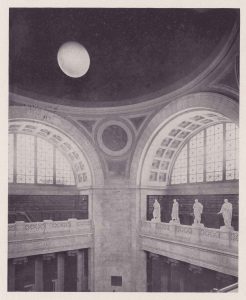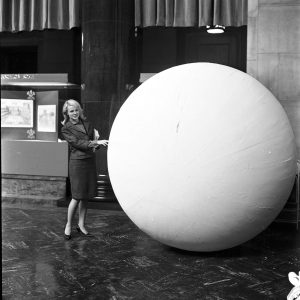In April 1897, the Spectator reported on the “two mysterious hemispheres” which had appeared in the entrance of the Library being built on Columbia’s soon-to-be new campus in Morningside Heights. First, the two halves were joined to form a globe. And then, this wooden sphere was hung from the ceiling and could cast a soft, moonlike light throughout the room. Moonlight inside the Library!

When Low Library opened in 1897, every Friday night between 5 and 7, visitors could enjoy a magical, artificial moonlight show. Hanging from the center of the domed ceiling over the Rotunda reading room, there used to be a 7-foot-in-diameter sphere, made out of wood, painted matte white, and weighing almost 500 pounds. Hidden in the upstairs galleries, there were a number of spotlights, which were aimed at the wooden globe. Like the Moon, the sphere would reflect the light and illuminate the galleries without casting shadows. This lighting system was engineered by Physics Professor William Hallock.

In 1898, Scientific American featured the new Library’s system of lighting by reflection “as used, we believe for the first time.” [1] The article notes the “considered originality” in solving the problem of how to illuminate the new Library’s high-domed ceiling. A suspended chandelier would cast shadows, “dazzle the eye and destroy the softness in architectural effect striven for.” But according to the Spectator, the light had “the quality of moonlight, but is so much brighter that it serves all the purposes of direct light and is far less trying to the eyes.” Alas, this magical light show would only last about two hours, due to the short life of the carbons used in the spotlights.

While it is unknown for how long the moonlight show illuminated (and surely delighted) library patrons, in January 1965 the Moon came down to Earth. As part of an extensive renovation of Low Library, a new light and sound system was installed and the moonball was rolled away.
[1] “Columbia’s Artificial Moon.” Scientific American, Vol, LXXVIII No. 15, April 9, 1898, 229.